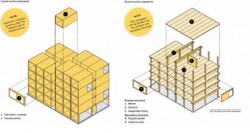A wider and more detailed understanding of structural timber has seen Timber Development UK (TDUK) launch a new guide to understanding options for those adopting timber construction.
In a bid to provide more knowledge and act as a guide to understanding construction options for low-carbon developers, 'Timber Typologies' outlines the variety of build options and methodologies available for low carbon timber construction and details the sort of building types, each method is suitable or appropriate for.
Aimed at developers, investors and policy makers and written with Waugh Thistleton Architects, one of the leading 'timber first' architects' practices in the UK, the book is intended as a primer or beginners guide to the variety of timber solutions available. It will help decision makers understand the options open to them and make the right choices to deliver the best outcomes.
"Timber is vital when it comes to decarbonising construction," says David Hopkins, Chief Executive at TDUK, However, if it is going to realise its full potential, we can no longer talk in simple generic terms about this material. We need to be specific about the systems and approaches available and the benefits and risks each of these can bring. We can't make progress if clients, architects and policy makers are talking at cross purposes about what they mean when they talk about building in timber."
'Timber Typologies' is the first in a trio of books aimed at increasing understanding options among the decision makers. It will be accompanied by 'Timber Policy' – a guide to the variety of ways countries and city authorities are encouraging timber construction around the world, and 'Timber LCA', examining comparisons of lifecycle analysis between buildings constructed of different materials.
Alastair Ogle, Associate at Waugh Thistleton Architects, and one of the lead authors of the book, said: "We still see enormous amounts of misinformation and misunderstanding when it comes to timber. Clients, local authorities and even insurers don't seem to understand that all of these things they refer to as 'timber' are in fact a wide range of completely different build systems with very different properties. We're committed to helping design and enable a low-carbon building revolution, but that will only come when we increase understanding across the market."
Long seen as a world leader in engineered timber and a pioneer of timber buildings, Waugh Thistleton are also at the centre of a recent Built by Nature €200,000 grant towards the development of a technical Commercial Timber Guidebook. Built by Nature is a network and grant-making fund accelerating the timber building transformation and is looking to foster cross-sector industry alignment on solutions to ensure the widespread adoption of large-scale mass timber offices.
The project lead is engineering consultancy Elliott Wood, joined by implementing partners Waugh Thistleton Architects, fire engineers OFR Consultants and insurance specialists Lignum Risk Partners. The development of the Commercial Timber Guidebook has additional backing and input from some of the largest investors, developers and asset owners in the UK including Stanhope PLC, Related Argent, Lendlease, British Land, Derwent London, Landsec, MUSE, Berkeley Estate Asset Management (BEAM) and Hines.
Built by Nature CEO Amanda Sturgeon said: "This is an exciting, important project given the scope of its cross-sector collaboration and the involvement of major UK developers. The Guidebook can be a milestone on the roadmap to wider acceptance of timber by creating a clear, peer reviewed framework for overcoming the insurance barriers."
The Guidebook will establish common ground and a realistic route for the wider adoption of structural timber in commercial buildings through consensus on defined design principles, mass timber building typologies and technical design measures.
For more information and to download 'Timber Typologies' visit: www.timberdevelopment.uk
For more information on Built by Nature visit: https://builtbn.org
Images: 01-02. Timber Typologies come in a variety of configurations









